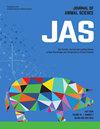252 评估添加大田豌豆(Pisum sativum)对奶牛瘤胃发酵概况、生产参数和瘤胃细菌群落组成的影响
IF 2.7
2区 农林科学
Q1 AGRICULTURE, DAIRY & ANIMAL SCIENCE
引用次数: 0
摘要
大田豌豆(FP)的特点是粗蛋白(CP)含量占干物质(DM)的 24% 到 28%。其中约 78% 的蛋白质可在瘤胃中降解。因此,豌豆粉可以作为家畜的一种可行的替代蛋白质来源。我们研究了用FP部分替代玉米精料对泌乳奶牛的生产参数、瘤胃发酵状况和瘤胃细菌群落组成的影响。对泌乳、未怀孕的荷斯坦奶牛(n = 12)进行了 3 × 3 拉丁方格重复试验,试验期为 21 天,最后 7 天用于样本和数据收集。奶牛饲喂的日粮为基础 TMR(对照组),或部分混合日粮,其中添加了 3.9%(LP)或 7.8% DM(HP)的 FP。对照组日粮含有17.4%的CP、4.5%的粗脂肪、28.0%的淀粉,以及约1.67兆卡/千克的泌乳净能(NEL)。FP含有22.5%的CP、1.67%的粗脂肪、44.7%的淀粉,泌乳净能(NEL)估计为1.81Mcal/kg。通过对 16S rRNA 基因 V4 区域进行高通量测序,分析了瘤胃细菌组成。饲喂HP日粮的奶牛的瘤胃氨(NH3-N)、乳尿素氮(MUN)和血浆尿素浓度高于饲喂对照组和LP日粮的奶牛(P<0.05)。与饲喂 HP 日粮的奶牛相比,饲喂对照组和 LP 日粮的奶牛的 DM 消化率更高(P & lt; 0.05)。随着日粮中豌豆含量的增加,CP总消化率降低(P & lt; 0.05)。与对照组相比,HP 日粮有增加支链挥发性脂肪酸瘤胃总浓度的趋势(P = 0.09)。日粮中添加FP不会影响瘤胃细菌群落的α多样性(香农指数)和β多样性[p(PERMANOVA) = 0.97]。然而,一些细菌类群的相对丰度,包括属于类杆菌、梭状芽孢杆菌和伽马蛋白菌的扩增子序列变体(ASVs),随着日粮中添加FP而降低。综上所述,我们的研究结果表明,在泌乳奶牛以玉米粒为基础的日粮中,FP的添加率最高可达7.8% DM,且不会对奶牛的产奶量、牛奶成分、瘤胃发酵特性和瘤胃微生物组成产生不利影响。本文章由计算机程序翻译,如有差异,请以英文原文为准。
252 Evaluating the impact of inclusion of field pea (Pisum sativum) on rumen fermentation profile, production parameters, and composition of rumen bacterial community of dairy cattle
Field peas (FP) are characterized by a crude protein (CP) content ranging from 24% to 28% of dry matter (DM). Approximately 78% of this protein is rumen degradable. Hence, FP can be a viable alternative protein source for livestock. We examined the effect of partially substituting corn-based concentrates with FP on production parameters, rumen fermentation profile, and the composition of the rumen bacterial community in lactating dairy cows. Lactating, non-pregnant Holstein cows (n = 12) were used in a repeated 3 × 3 Latin square with 21-d experimental periods, with the last 7 d used for sample and data collection. Cows were fed a basal TMR (control), or partially mixed diets to which 3.9% (LP), or 7.8% DM (HP) of FP were added. The control diet contained on a DM basis 17.4% CP, 4.5% crude fat, 28.0% starch, and an estimated 1.67 Mcal/kg of net energy for lactation (NEL). The FP contained 22.5% CP, 1.67% crude fat, 44.7% starch, and an estimated 1.81 Mcal NEL/kg. The rumen bacterial composition was analyzed by high-throughput sequencing of the V4 region of the 16S rRNA gene. Cows fed the HP diet had greater (P < 0.05) ruminal ammonia (NH3-N), milk urea nitrogen (MUN), and plasma urea concentrations than those fed control and LP diets. Digestibility of DM was greater (P < 0.05) for cows fed control and LP diets than for cows fed the HP diet. The CP total tract digestibility decreased (P < 0.05) with increasing levels of peas in the diet. Compared with the control, the HP diet tended (P = 0.09) to increase the total ruminal concentration of branched-chain volatile fatty acids. The addition of FP to the diets did not affect the alpha diversity, as indicated by Shannon’s index, and the beta diversity of the rumen bacterial community [p(PERMANOVA) = 0.97]. However, the relative abundances of several bacterial taxa, including amplicon sequence variants (ASVs) belonging to Bacteroidia, Clostridia, and Gammaproteobacteria decreased in response to the addition of FP to the diet. Taken together, our results suggest that up to an inclusion rate of 7.8% DM, FP can be included in corn grain-based diets of lactating dairy cows without adverse effects on milk yield, milk composition, rumen fermentation characteristics, and rumen microbial composition.
求助全文
通过发布文献求助,成功后即可免费获取论文全文。
去求助
来源期刊

Journal of animal science
农林科学-奶制品与动物科学
CiteScore
4.80
自引率
12.10%
发文量
1589
审稿时长
3 months
期刊介绍:
The Journal of Animal Science (JAS) is the premier journal for animal science and serves as the leading source of new knowledge and perspective in this area. JAS publishes more than 500 fully reviewed research articles, invited reviews, technical notes, and letters to the editor each year.
Articles published in JAS encompass a broad range of research topics in animal production and fundamental aspects of genetics, nutrition, physiology, and preparation and utilization of animal products. Articles typically report research with beef cattle, companion animals, goats, horses, pigs, and sheep; however, studies involving other farm animals, aquatic and wildlife species, and laboratory animal species that address fundamental questions related to livestock and companion animal biology will be considered for publication.
 求助内容:
求助内容: 应助结果提醒方式:
应助结果提醒方式:


